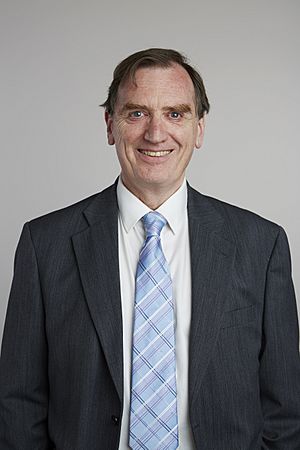Clifford Cocks facts for kids
Quick facts for kids
Clifford Cocks
|
|
|---|---|

Clifford Cocks at the Royal Society admissions day in London, July 2015
|
|
| Born |
Clifford Christopher Cocks
28 December 1950 Prestbury, Cheshire, England, United Kingdom
|
| Nationality | British |
| Education | Manchester Grammar School |
| Alma mater | University of Cambridge (BA) |
| Known for |
|
| Scientific career | |
| Fields | Cryptography |
| Institutions | |
Clifford Christopher Cocks (born 28 December 1950) is a British mathematician. He is also a cryptographer, which means he studies how to make and break secret codes. In the early 1970s, while working for the UK government, he created an important way to send secret messages. This method is called public-key cryptography.
Clifford Cocks's work was kept secret by the government until 1997. Because it was secret, his ideas did not affect how the internet became secure. Other people later invented similar systems on their own. These systems, like the Diffie–Hellman key exchange and parts of the RSA algorithm, became widely used.
Contents
Education and Early Career
Clifford Cocks went to Manchester Grammar School. He then studied for a maths degree at King's College, Cambridge. He continued his studies at the University of Oxford. There, he focused on number theory, which is a branch of mathematics. He left Oxford before finishing his advanced degree.
Career in Code-Breaking
Secret Encryption Discovery
In September 1973, Cocks joined a special part of the Government Communications Headquarters (GCHQ). GCHQ is the UK's intelligence and security agency. It helps protect the country's communications.
At GCHQ, Cocks learned about an idea called "non-secret encryption." This was a way to send secret messages without needing to share a secret key first. Many people had tried to make this idea work. Cocks, using his knowledge of number theory, found a solution. He used something called prime factorization, which is breaking numbers down into their prime parts. This quickly led him to develop what is now known as the RSA encryption algorithm.
GCHQ decided to keep Cocks's discovery a secret. They did not see a way to use it widely at the time. This was partly because computers were not very powerful back then. The secret method was also shared with the NSA in the United States.
In 1977, three other scientists, Rivest, Shamir, and Adleman, independently invented the same algorithm. They published their discovery, and it became known as RSA. There is no sign that they knew about Cocks's earlier work. Clifford Cocks himself has said he does not believe there was any leak.
Public Release of Secret Work
Clifford Cocks's amazing discovery stayed a secret for 24 years. The British government had planned to release the information in 1987. However, a book called Spycatcher caused them to delay the release.
Finally, on 18 December 1997, Cocks publicly shared the history of GCHQ's secret work on public-key cryptography. Sadly, James Ellis, who had the original idea for "non-secret encryption," had passed away a month before this announcement.
Identity-Based Encryption
In 2001, Cocks created another important encryption method. This was one of the first secure identity-based encryption (IBE) systems. IBE allows you to send a secret message to someone using their public identity, like their email address.
The Cocks IBE scheme is not used very often today. This is because the encrypted messages can become very long. However, it is still important because it uses different mathematical ideas than most other IBE systems.
Awards and Recognition
Clifford Cocks has received many awards for his work.
- In 1968, he won a silver medal at the 10th International Mathematical Olympiad. This is a competition for the best young mathematicians from around the world.
- He was the Chief Mathematician at GCHQ.
- He helped create the Heilbronn Institute for Mathematical Research at the University of Bristol.
- In 2008, he was made a Companion of the Order of the Bath. This is a special honour given by the British monarch.
- He received honorary degrees from the University of Bristol in 2008 and the University of Birmingham in 2015.
- In 2010, the Institute of Electrical and Electronics Engineers (IEEE) honoured Cocks, James Ellis, and Malcolm Williamson. They were recognized for their part in creating public-key cryptography.
- In 2021, he was added to the Cryptologic Hall of Honor. This recognizes people who have made major contributions to code-breaking.
- In 2015, Cocks was elected a Fellow of the Royal Society (FRS). The Royal Society is a very old and respected group of scientists. His election recognized his work in cryptography. It noted that his achievements have been key to keeping electronic communications safe around the world.

